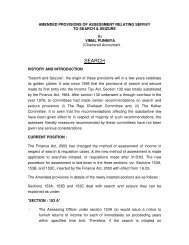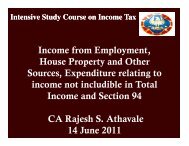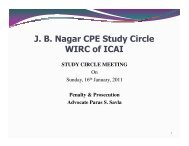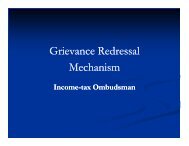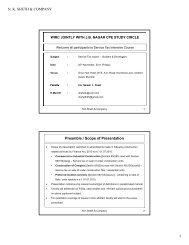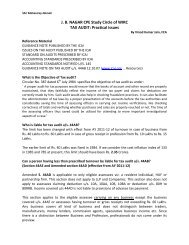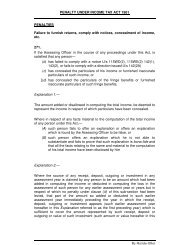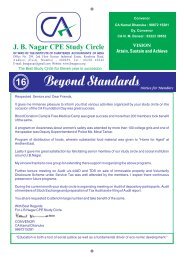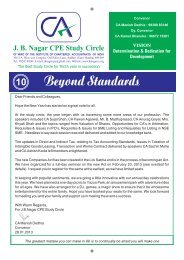Intrinsic Issues under MVAT, CST & VAT on Builders & Developers
Intrinsic Issues under MVAT, CST & VAT on Builders & Developers
Intrinsic Issues under MVAT, CST & VAT on Builders & Developers
- No tags were found...
Create successful ePaper yourself
Turn your PDF publications into a flip-book with our unique Google optimized e-Paper software.
Seminar of J.B. Nagar CPE Study Circle <strong>on</strong> 17.06.2012“<str<strong>on</strong>g>Intrinsic</str<strong>on</strong>g> <str<strong>on</strong>g>Issues</str<strong>on</strong>g> <str<strong>on</strong>g>under</str<strong>on</strong>g> <str<strong>on</strong>g>M<str<strong>on</strong>g>VAT</str<strong>on</strong>g></str<strong>on</strong>g>, <str<strong>on</strong>g>CST</str<strong>on</strong>g> & <str<strong>on</strong>g>VAT</str<strong>on</strong>g><strong>on</strong> <strong>Builders</strong> & <strong>Developers</strong>”Note <str<strong>on</strong>g>VAT</str<strong>on</strong>g> <strong>on</strong> <strong>Builders</strong> and <strong>Developers</strong>.C. B. THAKARB.Com., LLB, F.C.A.AdvocateAspects of <str<strong>on</strong>g>VAT</str<strong>on</strong>g> with relati<strong>on</strong> to Immovable Property and C<strong>on</strong>structi<strong>on</strong>C<strong>on</strong>tracts - An UpdateIn this seminar we have to discuss the legal positi<strong>on</strong> of tax <strong>on</strong> builders inlight of recent Bombay High Court judgment. However while preparing thisnote the said judgment is not available and hence I give the back groundand comments at the end about Bombay High Court observati<strong>on</strong>s given inthe judgment in case of Maharashtra Chamber of Housing Industry (WritPetiti<strong>on</strong> No. 2022 of 2007 dated 10.4.2012).(1) INTRODUCTIONIn relati<strong>on</strong> to immovable properties, the first thing, which comes to ourmind, is whether sale of immovable property attracts any sales tax? UnderSales Tax Laws the tax is leviable <strong>on</strong>ly <strong>on</strong> sale of ‘goods’. As per Sales TaxLaws, <strong>on</strong>ly moveable goods are c<strong>on</strong>sidered to be goods. Therefore immovableproperties of any nature cannot fall in the Sales Tax net. Therefore, sale offlats/shops etc. cannot be subject matter of Sales Tax. This isunc<strong>on</strong>troverted positi<strong>on</strong> and hence not dealt with further. However, whetherany particular transacti<strong>on</strong> is for sale of immovable property or is atransacti<strong>on</strong> of sale of moveable goods may become debatable.Such issues mainly arise when al<strong>on</strong>g with immovable property certainmovable goods in fixed c<strong>on</strong>diti<strong>on</strong> are also disposed of. For example, whiledisposing of Factory building there may also be disposal of machinery fixedin it. An attempt may be made by Sales Tax authorities to say that to theextent of machinery, there is sale. However this cannot be correct in allcases. It depends up<strong>on</strong> nature of machinery installed. The situati<strong>on</strong> can beseen from two angles. If al<strong>on</strong>g with immovable property any movable goodspasses, but without separate c<strong>on</strong>siderati<strong>on</strong>, then in such cases it can verywell be said that since c<strong>on</strong>siderati<strong>on</strong> is not bifurcated nor possible to be
- 2 -bifurcated, there is no sale of such moveable goods and hence no taxableevent arises.The other angle is that the moveable goods are fixed in the buildingand there is no intenti<strong>on</strong> to sever the same before transfer of immovableproperty. For example, the machinery is sold in fixed c<strong>on</strong>diti<strong>on</strong> and there isno intenti<strong>on</strong> to sever them. In such cases, even if values of factory buildingand machineries are shown separately, it can very well be argued that thereis sale of immovable property <strong>on</strong>ly and not of machinery, as there is nointenti<strong>on</strong> to deliver machinery separately as moveable goods. A reference canbe made am<strong>on</strong>gst others, to judgments of Maharashtra Sales Tax Tribunalin case of Lyods Steel Ind. (S.A.2091 of 98 dt.23.3.2001), HerdeliaChemicals Ltd. (S.A. 1826 of 1999 dt.31.10.2001), Basawraj PrintingPress (S.A.525 of 86 dt.30.11.87), Libra Leather Ind. Ltd. (S.A.479 &480 of 1988 dt.30.9.89), Paramount Sinters Ltd.(S.A.1220 of 1995dt.20.4.2002) and Pepsico India Holdings P. Ltd. (S.A.1074 of 2001dt.19.06.2002) etc.However if the facts turns out to be otherwise, i.e., there are separatevalues as well as intenti<strong>on</strong> to sever items is evident, then the transacti<strong>on</strong> tothe extent of moveable goods can be c<strong>on</strong>sidered as amounting to sale. Areference can be made to judgment in case of Indoswe Engg. Co.(S.A.1357of 98 dt.18.11.2000).Similar different situati<strong>on</strong>s can also arise in relati<strong>on</strong> to WorksC<strong>on</strong>tract theory and transfer of immovable property depending up<strong>on</strong> facts ofeach case. A reference can be made to judgment of M.S.T. Tribunal in caseof Sukhkarta Apartments (S.A.29 to 32 of 1996 dt.6.7.2002).In this case appellant was arguing that the activity is not covered bythe then Maharashtra Works C<strong>on</strong>tract Act since there is sale of immovableproperty, being sale of c<strong>on</strong>structed houses. Tribunal found that theagreement for sale of land and c<strong>on</strong>structi<strong>on</strong> of building were separate, andtherefore, though it was argued that it is sale of immovable property, ac<strong>on</strong>structed house, Tribunal held that the c<strong>on</strong>structi<strong>on</strong> part is liable toWorks C<strong>on</strong>tract, being separate c<strong>on</strong>structi<strong>on</strong> c<strong>on</strong>tract.
- 4 -(ii) the transfer of property in goods whether as goods or in some other form involved inthe executi<strong>on</strong> of a works c<strong>on</strong>tract including, an agreement for carrying out for cash,deferred payment or other valuable c<strong>on</strong>siderati<strong>on</strong>, the building, c<strong>on</strong>structi<strong>on</strong>,manufacture, processing, fabricati<strong>on</strong>, erecti<strong>on</strong>, installati<strong>on</strong>, fitting out, improvement,modificati<strong>on</strong>, repair or commissi<strong>on</strong>ing of any movable or immovable property ----“However inspite of above definiti<strong>on</strong> there will not be any change in thelegal positi<strong>on</strong> discussed above. Unless there are separate c<strong>on</strong>tracts for landand c<strong>on</strong>structi<strong>on</strong> no tax liability can be attracted.Having above preliminary observati<strong>on</strong>s about sales tax <strong>on</strong> immovableproperties, to my mind the more integrated issues in relati<strong>on</strong> to immovableproperties will arise in relati<strong>on</strong> to bringing into existence the immovableproperties. The discussi<strong>on</strong> in this paper is restricted to issues of WorksC<strong>on</strong>tract Tax <str<strong>on</strong>g>under</str<strong>on</strong>g> Maharashtra Value Added Tax Act,2002 (<str<strong>on</strong>g>VAT</str<strong>on</strong>g> Act). Inother words, the sales tax issues involved in relati<strong>on</strong> to c<strong>on</strong>structi<strong>on</strong> ofimmovable properties and c<strong>on</strong>structi<strong>on</strong> industry are dealt with here. A briefstudy <strong>on</strong> above lines can be as <str<strong>on</strong>g>under</str<strong>on</strong>g>.(2) POSSIBLE SITUATIONS OF WORKS CONTRACT TAX IN RELATION TOIMMOVABLE PROPERTIES AND CONSTRUCTION INDUSTRYNormally immovable properties mean the properties of the nature ofbuildings etc.. It can also include the factory buildings in which machineryetc. are embedded in it. In fact, the issue whether a property is moveable orimmovable, depends up<strong>on</strong> various factors, like nature of c<strong>on</strong>structi<strong>on</strong>,intenti<strong>on</strong> of parties and other relevant factors. The attempt here is not todiscuss nature of movable/immovable properties as such. For this paper thediscussi<strong>on</strong> is restricted to c<strong>on</strong>tracts of c<strong>on</strong>structi<strong>on</strong> of buildings etc. withrelati<strong>on</strong> to Works C<strong>on</strong>tract <str<strong>on</strong>g>under</str<strong>on</strong>g> <str<strong>on</strong>g>VAT</str<strong>on</strong>g> Act. In this respect followingsituati<strong>on</strong>s can be discussed.(i) Self c<strong>on</strong>structi<strong>on</strong> of propertyUnder this situati<strong>on</strong> normally a builder will develop property <strong>on</strong> his ownplot. He will purchase the building materials and will c<strong>on</strong>struct the same.Here no questi<strong>on</strong> of Works C<strong>on</strong>tract Tax arises since it is <strong>on</strong>e’s owndevelopment and no element of transfer of property in goods to other party isinvolved. Normally the sale will be of ready flats etc., i.e., immovable
- 5 -property and hence not liable to any tax. But if there is sale of any‘moveable’ items like sale of discarded items etc., to that extent, liability<str<strong>on</strong>g>under</str<strong>on</strong>g> <str<strong>on</strong>g>VAT</str<strong>on</strong>g> Act can arise. Here the issue is again required to be seen in lightof judgment in case of K. Raheja C<strong>on</strong>structi<strong>on</strong>(cited supra). The abovejudgment pertained mainly to Developer and its full implicati<strong>on</strong>s arediscussed later. However in this judgment the Supreme Court has observedthat even if <strong>on</strong>e is not developer but c<strong>on</strong>structing <strong>on</strong> his own land, still ingiven circumstances he can be liable to tax. In other words, a dealerc<strong>on</strong>structing buildings <strong>on</strong> his own land but entering into agreement for saleof flats etc. before completi<strong>on</strong> of c<strong>on</strong>structi<strong>on</strong>, can be liable to tax <str<strong>on</strong>g>under</str<strong>on</strong>g> <str<strong>on</strong>g>VAT</str<strong>on</strong>g>Act. This aspect is to be seen al<strong>on</strong>g with the issues discussed subsequentlyin relati<strong>on</strong> to developer.A point about issue of ‘C’ forms for purchase of building materialsfrom other states in above situati<strong>on</strong>, can be c<strong>on</strong>sidered here. As builder maybe getting registered <str<strong>on</strong>g>under</str<strong>on</strong>g> <str<strong>on</strong>g>VAT</str<strong>on</strong>g> Act he can also get himself registered <str<strong>on</strong>g>under</str<strong>on</strong>g><str<strong>on</strong>g>CST</str<strong>on</strong>g> Act and hence will become entitled to issue of ‘C’ forms against hispurchases. However it may be remembered that when the builder ispurchasing the materials for his own c<strong>on</strong>structi<strong>on</strong> he cannot be entitled topurchase materials against ‘C’ forms. When he purchases materials forc<strong>on</strong>structi<strong>on</strong> of building etc. the intensi<strong>on</strong> is to effect sale of ready flats etc..Surely the materials so purchased against ‘C’ forms cannot be said to be forpurpose of resale or for use in manufacturing of goods for sale etc.. There isno resale or such use in manufacturing etc., when materials are used inc<strong>on</strong>structi<strong>on</strong> and therefore such use is not fulfilling c<strong>on</strong>diti<strong>on</strong> of permissibleuses in ‘C’ form. Therefore, purchases against ‘C’ form is not allowable tobuilder <str<strong>on</strong>g>under</str<strong>on</strong>g> above circumstances. However if the c<strong>on</strong>structi<strong>on</strong> is <strong>on</strong>ewhich is liable to <str<strong>on</strong>g>VAT</str<strong>on</strong>g> (as in case of K. Raheja) than ‘C’ form can be issued.(ii) C<strong>on</strong>structi<strong>on</strong> <strong>on</strong> land bel<strong>on</strong>ging to other <strong>on</strong> the basis ofDevelopment agreementUnder this type, normally a builder will enter into agreement fordevelopment of land bel<strong>on</strong>ging to other party. It will be joint developmentagreement. It is assumed here that the c<strong>on</strong>structi<strong>on</strong> is not for landlord butby joint development. Builder will be c<strong>on</strong>structing a building for sale of
- 8 -Act. From 20.6.2006 the term is defined as reproduced earlier. The effect ofK. Raheja is to be seen in light of this development and if facts are similar tofacts in case of K. Raheja liability can arise. As per Supreme Court, enteringinto agreement before the c<strong>on</strong>structi<strong>on</strong> is complete, amounts to deemedsale, by way of transfer of property in goods in the executi<strong>on</strong> of WorksC<strong>on</strong>tract. However it has to be kept in mind that the above judgment canapply, where the value of land and c<strong>on</strong>structi<strong>on</strong> is separately menti<strong>on</strong>ed andagreed up<strong>on</strong>. This positi<strong>on</strong> also gets supported from judgment of GauhatiHigh Court in case of Magus C<strong>on</strong>structi<strong>on</strong> P. Ltd. v. Uni<strong>on</strong> of India (15VST 17) (Gauhati), wherein the judgment in K. Rahaja is distinguished. Inmajority cases in Maharashtra composite values are shown. Therefore itsapplicability will be limited to the cases where land value and c<strong>on</strong>structi<strong>on</strong>is shown separately.In the Budget Speech of Finance Minister delivered <strong>on</strong> 19.3.2008 inthe Assembly it was menti<strong>on</strong>ed that a deducti<strong>on</strong> for land price in aC<strong>on</strong>structi<strong>on</strong> C<strong>on</strong>tract will be provided to find out taxable price. AccordinglyGovernment has prescribed Rule 58(1A). The short analysis of above rule58(1A) is as <str<strong>on</strong>g>under</str<strong>on</strong>g>:Rule 58 (1A) – Brief Analysis of RuleVide Notificati<strong>on</strong> dtd. 01.06.2009, the Government of Maharashtra has inserted Rule-58(1A)in the <str<strong>on</strong>g>M<str<strong>on</strong>g>VAT</str<strong>on</strong>g></str<strong>on</strong>g> Rules, 2005. The said rule is introduced for granting deducti<strong>on</strong> for cost of landfrom total c<strong>on</strong>tract value. The said rule is reproduced below for ready reference.“(1A) In case of a c<strong>on</strong>structi<strong>on</strong> c<strong>on</strong>tract, where al<strong>on</strong>gwith the immovable property, theland or, as the case may be, interest in the land, <str<strong>on</strong>g>under</str<strong>on</strong>g>lying the immovable property is tobe c<strong>on</strong>veyed, and the property in the goods (whether as goods or in some other form)involved in the executi<strong>on</strong> of the c<strong>on</strong>structi<strong>on</strong> c<strong>on</strong>tract is also transferred to the purchasersuch transfer is liable to tax <str<strong>on</strong>g>under</str<strong>on</strong>g> this rule. The value of the said goods at the time of thetransfer shall be calculated after making the deducti<strong>on</strong>s <str<strong>on</strong>g>under</str<strong>on</strong>g> sub-rule(1) and the cost ofthe land from the total agreement value.The cost of the land shall be determined in accordance with the guidelinesappended to the Annual Statement of Rates prepared <str<strong>on</strong>g>under</str<strong>on</strong>g> the provisi<strong>on</strong>s of the Bombay
- 9 -Stamp (Determinati<strong>on</strong> of True Market Value of Property) Rules, 1995, as applicable <strong>on</strong> the1 st January of the year in which the agreement to sell the property is registered.Provided that, deducti<strong>on</strong> towards cost of land <str<strong>on</strong>g>under</str<strong>on</strong>g> this sub-rule shall not exceed70% of the agreement value.”The back ground of this rule is that, in light of judgment of SupremeCourt in case of Raheja Development Corporati<strong>on</strong> (141 STC 298) thegovernment <str<strong>on</strong>g>under</str<strong>on</strong>g>stands that <str<strong>on</strong>g>under</str<strong>on</strong>g> c<strong>on</strong>structi<strong>on</strong> c<strong>on</strong>tracts are liable to tax<str<strong>on</strong>g>under</str<strong>on</strong>g> <str<strong>on</strong>g>M<str<strong>on</strong>g>VAT</str<strong>on</strong>g></str<strong>on</strong>g> as works c<strong>on</strong>tracts. Accordingly, definiti<strong>on</strong> of works c<strong>on</strong>tract isalso inserted in the Act from 20.06.2006. In light of above <str<strong>on</strong>g>under</str<strong>on</strong>g>standingthe government has thought it fit to grant deducti<strong>on</strong> for cost of land, so thatultimately the tax is attracted <strong>on</strong> value of materials used in the c<strong>on</strong>tract.However the above <str<strong>on</strong>g>under</str<strong>on</strong>g>standing of government is subject to furtherlitigati<strong>on</strong>. The judgment in Raheja Development Corporati<strong>on</strong> (141 STC298) itself is referred to Larger Bench by Supreme Court in case of Larsen& Toubro Limited and another Vs. State of Karnataka and another. (17VST 460).The amendment in <str<strong>on</strong>g>M<str<strong>on</strong>g>VAT</str<strong>on</strong>g></str<strong>on</strong>g> Act, 2002 c<strong>on</strong>templating tax <strong>on</strong> <str<strong>on</strong>g>under</str<strong>on</strong>g>c<strong>on</strong>structi<strong>on</strong> c<strong>on</strong>tracts is also challenged before Bombay High Court.However, pending the litigati<strong>on</strong>, the government has provided above rule togive deducti<strong>on</strong> for cost of land from c<strong>on</strong>tract value. The analysis of aboverule give rise to following issues.a) The rule is to apply in case of c<strong>on</strong>structi<strong>on</strong> c<strong>on</strong>tract, where the c<strong>on</strong>veyanceof land or interest in land (immovable property) is c<strong>on</strong>templated in suchc<strong>on</strong>tract, al<strong>on</strong>gwith transfer of property in goods involved in such c<strong>on</strong>tract.In short, the rule is stated to apply where both, immovable property as wellas movable property are involved.Though rule c<strong>on</strong>templates as above, the legality of such positi<strong>on</strong> is notfree from doubt. There appears to be no power to bifurcate c<strong>on</strong>tract valueinto immovable property and others, when the value of c<strong>on</strong>tract iscomposite. In other words, the state government has no power to noti<strong>on</strong>allydivide composite c<strong>on</strong>tract involving immovable property and movableproperty. The power as available <str<strong>on</strong>g>under</str<strong>on</strong>g> Article 366 (29A)(b) in respect ofworks c<strong>on</strong>tract is lacking in case of c<strong>on</strong>tract involving immovable property.As such legality of this rule can be challenged before proper forum.
- 11 -method of discharging liability. Therefore, the core issue whether builder, <strong>on</strong>the given facts, is liable to tax or not is to be seen in light of legal positi<strong>on</strong>discussed above. If the builder c<strong>on</strong>siders himself liable to tax then inadditi<strong>on</strong> to the other methods he can now discharge liability by way of thisnew compositi<strong>on</strong> scheme.1% Compositi<strong>on</strong> Scheme for <strong>Builders</strong> & <strong>Developers</strong>Certain Important aspects of the above Notificati<strong>on</strong> can be noted as<str<strong>on</strong>g>under</str<strong>on</strong>g>:a) The Scheme is notified by Notificati<strong>on</strong> dated 9.7.2010 issued <str<strong>on</strong>g>under</str<strong>on</strong>g> 42(3A).The scheme applies to <strong>Builders</strong>/<strong>Developers</strong>, who <str<strong>on</strong>g>under</str<strong>on</strong>g>take the c<strong>on</strong>structi<strong>on</strong>of flats etc., wherein they also transfer land or interest <str<strong>on</strong>g>under</str<strong>on</strong>g>lying the land.Normally, <strong>Builders</strong>/<strong>Developers</strong> commence c<strong>on</strong>structi<strong>on</strong> <strong>on</strong> their own land asper their own project planning. The land is to be transferred to the societyor associati<strong>on</strong> which may be formed by the buyers of the premisescollectively, after possessi<strong>on</strong> is given. An issue may arise that there will notbe transfer of land or interest in land to any individual purchaser withwhom agreements are entered into. In case of flats/premises, each saleagreement can be c<strong>on</strong>sidered to be c<strong>on</strong>structi<strong>on</strong> c<strong>on</strong>tract. Therefore, if <strong>on</strong>ereads the Notificati<strong>on</strong> literally then it may be said that when the land orinterest in land is not transferred to the very individual purchaser, thenotificati<strong>on</strong> can not apply. Therefore, to avoid any dispute in future, thedepartment is required to clarify about nature of transfer of land or interestin land, wherein it may be clarified that transfer to society etc., will also beeligible for the Compositi<strong>on</strong> Scheme.b) The Scheme can apply to registered dealers <strong>on</strong>ly. It is possible that in view ofdebatable positi<strong>on</strong>, the <strong>Builders</strong>/<strong>Developers</strong> are not registered <str<strong>on</strong>g>under</str<strong>on</strong>g> <str<strong>on</strong>g>M<str<strong>on</strong>g>VAT</str<strong>on</strong>g></str<strong>on</strong>g>Act, 2002. However, if they wish to take benefit of this Scheme at thismoment or any time in future, it is necessary that they remain registereddealer. However, being registered it doesn’t mean that the Builder isaccepting the liability. He can be registered dealer but can still show noturnover in the returns, c<strong>on</strong>sidering his c<strong>on</strong>tracts as c<strong>on</strong>tracts forimmovable property. In future, if the liability accrues because of clarity in
- 12 -the legal positi<strong>on</strong>, he can opt for this Scheme. Though <strong>on</strong>e of the c<strong>on</strong>diti<strong>on</strong>smenti<strong>on</strong> that the dealer should include the c<strong>on</strong>tract price in the return inwhich the agreement is registered and pay the tax <strong>on</strong> it by declaring suchc<strong>on</strong>tract price as turnover, this can be d<strong>on</strong>e even by revising the return atappropriate time. Therefore, at present, awaiting clarity of the law, buildercan file return without declaring turnover of such c<strong>on</strong>tracts.It can also be noted that if the Builder applies today for registrati<strong>on</strong>,his earlier transacti<strong>on</strong>s from 20.06.2006 <strong>on</strong>wards will also be scrutinized forlevy of liability. This new Compositi<strong>on</strong> Scheme does not bring new tax but it<strong>on</strong>ly provides <strong>on</strong>e more method for discharging liability effective from01.04.2010. Assuming that Builder opts for this Compositi<strong>on</strong> Scheme from01.04.2010, he can c<strong>on</strong>test the liability for past period, if the issue arises.c) The Scheme is applicable to agreements registered after 01.04.2010.Therefore, even if the agreement is executed earlier but registered after01.04.2010, it will be eligible.d) The Compositi<strong>on</strong> m<strong>on</strong>ey is 1% of the agreement amount, specified in theagreement or value adopted for the purpose of stamp duty, whichever ishigher. The c<strong>on</strong>diti<strong>on</strong> also debars set off <strong>on</strong> the purchases. The furtherc<strong>on</strong>diti<strong>on</strong>s also debar such dealer from effecting purchases against ‘C’ forms,as well as debars from issuing form no. 409 to the sub-c<strong>on</strong>tractors. Thefurther c<strong>on</strong>diti<strong>on</strong>s also menti<strong>on</strong> that the dealer will not be entitled to changethe method of computati<strong>on</strong> of tax liability. From the plain reading, it appearsthat this c<strong>on</strong>diti<strong>on</strong> is to be seen qua each c<strong>on</strong>tract and not project as awhole. The last c<strong>on</strong>diti<strong>on</strong> menti<strong>on</strong>s that the dealer <str<strong>on</strong>g>under</str<strong>on</strong>g> this Compositi<strong>on</strong>Scheme should not issue tax invoice. The issue may arise as to whetherBuilder can collect 1% compositi<strong>on</strong> separately. Though, the provisi<strong>on</strong>srelating to tax invoice are not worded happily, form the clarificati<strong>on</strong> issuedby the Commissi<strong>on</strong>er of Sales Tax, it can be said that though tax invoicecannot be issued, still in the normal invoice or bill etc., the Builder cancharge compositi<strong>on</strong> amount separately. Otherwise he has to include in theagreement price.From the overall scenario, it appears that though there is uncertaintyabout attracti<strong>on</strong> of sales tax liability <strong>on</strong> <str<strong>on</strong>g>under</str<strong>on</strong>g> c<strong>on</strong>structi<strong>on</strong> c<strong>on</strong>tracts, the
- 13 -<strong>Builders</strong>/<strong>Developers</strong> may c<strong>on</strong>sider the risk factor and may pass <strong>on</strong> theburden to the prospective purchasers. This will result in burden up<strong>on</strong> thecomm<strong>on</strong> pers<strong>on</strong>. The issue will be more aggravating, if ultimately theliability is not upheld by the judicial forum. There will be number ofdifficulties in getting back the tax which was not due to the government. Theearliest clarificati<strong>on</strong> of legal positi<strong>on</strong> is the need of the day.Development <strong>on</strong> Barter BasisIn certain c<strong>on</strong>structi<strong>on</strong> transacti<strong>on</strong>s the builder/developer is liable toc<strong>on</strong>struct premises for land owner for allowing development right etc.. Theissue is, whether the builder (developer) is liable to pay tax <strong>on</strong> suchtransacti<strong>on</strong>. For example X allows Y to develop <strong>on</strong> his land. In c<strong>on</strong>siderati<strong>on</strong>thereof Y is <str<strong>on</strong>g>under</str<strong>on</strong>g> obligati<strong>on</strong> to handover specific number of premises to Xwithout any receipt of m<strong>on</strong>ey from X i.e. free. The issue is whether anyliability <str<strong>on</strong>g>under</str<strong>on</strong>g> <str<strong>on</strong>g>VAT</str<strong>on</strong>g> law arises in such case. Thus the main issue in suchcase is about liability, if any, as works c<strong>on</strong>tract in relati<strong>on</strong> to handing over ofpremises to X. The c<strong>on</strong>cerned land bel<strong>on</strong>gs to X. Y will be c<strong>on</strong>structingbuilding <strong>on</strong> X’s land using his building materials etc. in relati<strong>on</strong> to premiseshanded over to X. There is thus transfer of property from Y to X. In normalcourse this transacti<strong>on</strong> would have amounted to taxable works c<strong>on</strong>tract andliable to tax. However in this case the situati<strong>on</strong> is peculiar.As per Sales Tax Laws to be a taxable sale transacti<strong>on</strong> <str<strong>on</strong>g>under</str<strong>on</strong>g> SalesTax Laws it is necessary that the c<strong>on</strong>siderati<strong>on</strong> is in m<strong>on</strong>ey terms.The legal positi<strong>on</strong> in this regard can be elaborated, briefly as <str<strong>on</strong>g>under</str<strong>on</strong>g>.The term ‘sale’ is defined as <str<strong>on</strong>g>under</str<strong>on</strong>g> in secti<strong>on</strong> 2(24) of <str<strong>on</strong>g>M<str<strong>on</strong>g>VAT</str<strong>on</strong>g></str<strong>on</strong>g> Act,2002as <str<strong>on</strong>g>under</str<strong>on</strong>g>:“(24) “sale” means a sale of goods made within the State for cash or deferred payment orother valuable c<strong>on</strong>siderati<strong>on</strong> but does not include a mortgage, hypothecati<strong>on</strong>, charge orpledge; and the words “sell”, “buy” and “purchase”, with all their grammatical variati<strong>on</strong>sand cognate expressi<strong>on</strong>s, shall be c<strong>on</strong>strued accordingly;....”Thus, the transacti<strong>on</strong> to be a sale, it should be a sale of goods forcash, deferred payment or other valuable c<strong>on</strong>siderati<strong>on</strong>. Unless m<strong>on</strong>eyc<strong>on</strong>siderati<strong>on</strong> is agreed up<strong>on</strong>, there is no questi<strong>on</strong> of ‘sale’ as per Sales TaxLaws.
- 15 -(ii)(iii)(iv)The subject matter of sale is moveable goods,There must be m<strong>on</strong>ey c<strong>on</strong>siderati<strong>on</strong> andTransfer of property i.e. transfer of ownership from seller to purchaser.Thus it is clear that there should be c<strong>on</strong>siderati<strong>on</strong> against the transferof ownership in goods.The c<strong>on</strong>siderati<strong>on</strong> has to be in m<strong>on</strong>ey terms. If the c<strong>on</strong>siderati<strong>on</strong> is not inm<strong>on</strong>ey terms but in any other mode it may be case of barter or exchange butnot ‘sale’.C.I.T. v. Motors & General Stores (P) Ltd. (66 ITR 692)In this respect reference can be made to the Supreme Court judgment incase of C.I.T. v. Motors & General Stores (P) Ltd. 66 ITR 692. In thiscase, Supreme Court has observed as <str<strong>on</strong>g>under</str<strong>on</strong>g> <strong>on</strong> page 695/696 of 66 ITR:“Secti<strong>on</strong> 54 of the Transfer of Property Act defines ‘sale’ as a transfer of ownership inexchange for a price paid or promised or part paid and part promised. Secti<strong>on</strong> 54 of theTransfer of Property Act reads as follows:“sale’ is a transfer of ownership in exchange for a price paid or promised or part paid andpart promised”There is no definiti<strong>on</strong> of the words ‘price’ in this Act. But it is well settled that the word‘price’ is used in the same sense in this secti<strong>on</strong> as in secti<strong>on</strong> 4 of the Sales of Goods Act,1930(Act III of 1930) (see the decisi<strong>on</strong>s of a full Bench of the Madras High Court in Madam Pillaiv. Badrakali Ammal) Secti<strong>on</strong> 4 of the Sale of Goods Act reads as follows:(1) A c<strong>on</strong>tract of sale of goods is a c<strong>on</strong>tract whereby the seller transfers or agrees totransfer the property in goods to the buyer for a price. There may be a c<strong>on</strong>tract ofsale between <strong>on</strong>e part owner and another.(2) A c<strong>on</strong>tract of sale may be absolute or c<strong>on</strong>diti<strong>on</strong>al.(3) Where <str<strong>on</strong>g>under</str<strong>on</strong>g> a c<strong>on</strong>tract of sale the property in the goods is transferred from theseller to the buyer, the c<strong>on</strong>tract is called a sale, but where the transfer of theproperty in the goods is to take place at a future time or subject to some c<strong>on</strong>diti<strong>on</strong>thereafter to be fulfilled, the c<strong>on</strong>tract is called an agreement to sell.(4) An agreement to sell becomes a sale, when the time elapses or the c<strong>on</strong>diti<strong>on</strong>s arefulfilled subject to which the property in the goods is to be transferred.”
- 16 -Secti<strong>on</strong> 2(10) of the Sale of Goods Act defines ‘price’ as meaning the m<strong>on</strong>eyc<strong>on</strong>siderati<strong>on</strong> for a sale of goods. The presence of m<strong>on</strong>ey c<strong>on</strong>siderati<strong>on</strong> is therefore anessential element in a transacti<strong>on</strong> of sale. If the c<strong>on</strong>siderati<strong>on</strong> is not m<strong>on</strong>ey but someother valuable c<strong>on</strong>siderati<strong>on</strong> it may be an exchange or barter but not a sale.”(<str<strong>on</strong>g>under</str<strong>on</strong>g>lining ours).M/s.Davi Dass Gopal Krishnan and Others (22 STC 430)(SC)In this case the issue arose as to whether ‘other valuable c<strong>on</strong>siderati<strong>on</strong>’ willinclude c<strong>on</strong>siderati<strong>on</strong> other then m<strong>on</strong>ey. H<strong>on</strong>.Supreme Court has observedas <str<strong>on</strong>g>under</str<strong>on</strong>g> <strong>on</strong> page 444/445:“Bearing that in mind let us look at clause (ff) in secti<strong>on</strong> 2 of the principal Act in which thesaid clause was inserted. The ingredients of the definiti<strong>on</strong> of ‘purchase’ are as follows: (i)there shall be acquisiti<strong>on</strong>s of goods; (ii) the acquisiti<strong>on</strong> shall be for cash or deferred paymentor other valuable c<strong>on</strong>siderati<strong>on</strong>; (iii) the said valuable c<strong>on</strong>siderati<strong>on</strong> shall not be other than<str<strong>on</strong>g>under</str<strong>on</strong>g> a mortgage, hypothecati<strong>on</strong>, charge or pledge. Clause (h) of secti<strong>on</strong> 2 defines ‘sale’thus:‘sale’ means any transfer of property in goods other than goods specified in Schedule C forcash or deferred payment or other valuable c<strong>on</strong>siderati<strong>on</strong> but does not include a mortgage,hypothecati<strong>on</strong>, charge or pledge.If we turn to the Sale of Goods Act, secti<strong>on</strong> 4 thereof defines a c<strong>on</strong>tract of sale ofgoods. It reads:“A c<strong>on</strong>tract of sale of goods is a c<strong>on</strong>tract whereby the seller transfers or agrees to transferthe property in goods to the buyer for a price….”The essential requisites of sale are (i) there shall be a transfer of property or agreement totransfer property by <strong>on</strong>e party to another; and (ii) it shall be for c<strong>on</strong>siderati<strong>on</strong> of m<strong>on</strong>eypayment or promise thereof by the buyer. …Now, coming to the expressi<strong>on</strong> ‘price’, it is no doubt defined in the Sale of Goods as‘m<strong>on</strong>ey c<strong>on</strong>siderati<strong>on</strong>’. Cash or deferred payment in clause (ff) of secti<strong>on</strong> 2 of the Actsatisfies the said definiti<strong>on</strong>. The expressi<strong>on</strong> ‘valuable c<strong>on</strong>siderati<strong>on</strong>’ has a widerc<strong>on</strong>notati<strong>on</strong>, but the said expressi<strong>on</strong> is also used in the same collocati<strong>on</strong> in the definiti<strong>on</strong> of‘sale’ in secti<strong>on</strong> 2(h) of the Act. The said expressi<strong>on</strong> must bear the same meaning in clause(ff) and clause (h) of secti<strong>on</strong> 2 of the Act. It may also be noticed that in most of the sales tax
- 17 -acts the same three expressi<strong>on</strong>s are used. It has never be argued or decided that the saidexpressi<strong>on</strong> means other than m<strong>on</strong>etary c<strong>on</strong>siderati<strong>on</strong>. This c<strong>on</strong>sistent legislative practicescannot be ignored. The expressi<strong>on</strong> ‘valuable c<strong>on</strong>siderati<strong>on</strong>’ takes colour from the precedingexpressi<strong>on</strong> ‘cash or deferred payment’. If so, it can <strong>on</strong>ly mean some other m<strong>on</strong>etarypayment in the nature of cash or deferred payment. We, therefore, hold that clause (ff) ofsecti<strong>on</strong> 2 of the Act is not void for legislative incompetence.”(<str<strong>on</strong>g>under</str<strong>on</strong>g>lining ours)Thus “other valuable c<strong>on</strong>siderati<strong>on</strong>” used in definiti<strong>on</strong> reproducedabove will have the meaning as c<strong>on</strong>siderati<strong>on</strong> in m<strong>on</strong>ey terms <strong>on</strong>ly and notany other c<strong>on</strong>siderati<strong>on</strong>.M/s.Radhas Printers v. State of Kerala (90 STC 201) (Kerala)In this judgment also applying the law laid down by H<strong>on</strong>.Supreme Court inDevi Dass Gopal Krishnan, the Kerala High Court has held as <str<strong>on</strong>g>under</str<strong>on</strong>g> <strong>on</strong> page205/206:“11.These decisi<strong>on</strong>s therefore cannot be treated to hold that ‘other valuable c<strong>on</strong>siderati<strong>on</strong>’could be goods or other property and that c<strong>on</strong>siderati<strong>on</strong> need not be m<strong>on</strong>ey c<strong>on</strong>siderati<strong>on</strong>.In the decisi<strong>on</strong>s in Sales Tax Commissi<strong>on</strong>er v. Ram Kumar Agarwal (1967) 19 STC 400, theAllahabad High Court held that ‘other valuable c<strong>on</strong>siderati<strong>on</strong>’ which occurs in secti<strong>on</strong> 2(h) ofthe U.P. Sales Tax Act,1948, must be interpreted <strong>on</strong> the basis of the rule of ejusdem generisto mean cheques, bills of exchange or such other negotiable instruments and that theycannot cover a case where no price is paid. The Supreme Court in the decisi<strong>on</strong> in Devi DasssGopal Krishnan v. State of Punjab (1967) 20 STC 430 held that the expressi<strong>on</strong> ‘valuablec<strong>on</strong>siderati<strong>on</strong>’ takes colour from the preceding expressi<strong>on</strong> cash or deferred payment. Thusto c<strong>on</strong>stitute ‘sale’ within the meaning of the KDST Act, the same should be forc<strong>on</strong>siderati<strong>on</strong> either in cash or deferred payment, or other valuable c<strong>on</strong>siderati<strong>on</strong>; andother valuable c<strong>on</strong>siderati<strong>on</strong> in the c<strong>on</strong>text must be interpreted to mean cheques, bills ofexchanges or any such negotiable instruments.”(<str<strong>on</strong>g>under</str<strong>on</strong>g>lining ours)Thus the legal positi<strong>on</strong> is more than clear that unless the transferof property by the seller to buyer is against m<strong>on</strong>ey c<strong>on</strong>siderati<strong>on</strong> therecannot be ‘sale’ transacti<strong>on</strong> for the purposes of sale tax laws.
- 18 -In above example of X, the c<strong>on</strong>siderati<strong>on</strong> is in form of allowingdevelopment. It is not in m<strong>on</strong>ey terms. It is transacti<strong>on</strong> of barter but nottransacti<strong>on</strong> of sale by way of works c<strong>on</strong>tract. Therefore the transacti<strong>on</strong>between Y and X is not a taxable Works C<strong>on</strong>tract <str<strong>on</strong>g>under</str<strong>on</strong>g> Sales Tax Laws andno liability as Works C<strong>on</strong>tract is attracted.(iii) C<strong>on</strong>structi<strong>on</strong> C<strong>on</strong>tractorThe normal positi<strong>on</strong> which we come across day to day is that adeveloper/builder gets the work of c<strong>on</strong>structi<strong>on</strong> completed through thec<strong>on</strong>tractor. He may award the whole c<strong>on</strong>structi<strong>on</strong> work to <strong>on</strong>e c<strong>on</strong>tractor ormay divide the work and award different works to different c<strong>on</strong>tractors. Forexample, he may appoint <strong>on</strong>e c<strong>on</strong>tractor for whole c<strong>on</strong>structi<strong>on</strong> or mayappoint different c<strong>on</strong>tractors for different works, like for c<strong>on</strong>structi<strong>on</strong>, forelectrical fittings etc..However in all these cases the c<strong>on</strong>tractor will be the pers<strong>on</strong> who willbe liable to discharge tax liability. As a c<strong>on</strong>tractee or employer, builder willnot be liable to any Works C<strong>on</strong>tract Tax. There is no c<strong>on</strong>cept of unregistereddealer purchases <str<strong>on</strong>g>under</str<strong>on</strong>g> <str<strong>on</strong>g>VAT</str<strong>on</strong>g> Act and hence whether the c<strong>on</strong>tractor isregistered or not, no liability <strong>on</strong> builder can arise as purchases from URDetc.It may also be noted that if builder himself purchases the goods andgives c<strong>on</strong>tract for labour porti<strong>on</strong> <strong>on</strong>ly, then there is no questi<strong>on</strong> of anyliability <str<strong>on</strong>g>under</str<strong>on</strong>g> <str<strong>on</strong>g>VAT</str<strong>on</strong>g> Act. Thus the liability, if any, is to be seen in light ofabove facts. Even if the purchases are from unregistered dealers, still therewill not be any liability <strong>on</strong> such purchases <str<strong>on</strong>g>under</str<strong>on</strong>g> <str<strong>on</strong>g>VAT</str<strong>on</strong>g> Act as there is noc<strong>on</strong>cept of levy of purchase tax.In fact <str<strong>on</strong>g>under</str<strong>on</strong>g> above category many different situati<strong>on</strong>s can arisedepending up<strong>on</strong> the facts of each case. The facts of each agreement are to bec<strong>on</strong>sidered carefully to see whether the c<strong>on</strong>tract is covered by <str<strong>on</strong>g>VAT</str<strong>on</strong>g> Act or notand accordingly the liability, if any, be decided.In this respect it can further be noted that if builder gives the c<strong>on</strong>tractliable <str<strong>on</strong>g>under</str<strong>on</strong>g> <str<strong>on</strong>g>VAT</str<strong>on</strong>g> Act to c<strong>on</strong>tractor, then his liability can be <strong>on</strong>ly upto the
- 19 -extent of Deducti<strong>on</strong> of Tax <strong>on</strong> c<strong>on</strong>tract and payment of same to Government.As stated above there is no direct burden of tax <strong>on</strong> him. The indirect taxburden will fall <strong>on</strong> builder, as c<strong>on</strong>tractor will pass <strong>on</strong> his burden to thebuilder and hence builder should be aware of the provisi<strong>on</strong>s of <str<strong>on</strong>g>VAT</str<strong>on</strong>g> Act toestimate and seek ways for minimizing the tax burden. The varioussituati<strong>on</strong>s of discharging Works C<strong>on</strong>tact tax <str<strong>on</strong>g>under</str<strong>on</strong>g> <str<strong>on</strong>g>VAT</str<strong>on</strong>g> Act are discussedbelow which can be c<strong>on</strong>sidered for estimating the liability.Similarly the TDS provisi<strong>on</strong>s <str<strong>on</strong>g>under</str<strong>on</strong>g> <str<strong>on</strong>g>VAT</str<strong>on</strong>g> Act are also discussed belowwhich should be kept in mind.Discharging tax liability <str<strong>on</strong>g>under</str<strong>on</strong>g> <str<strong>on</strong>g>M<str<strong>on</strong>g>VAT</str<strong>on</strong>g></str<strong>on</strong>g> Act,2002Following are five ways of discharging tax liability <str<strong>on</strong>g>under</str<strong>on</strong>g> <str<strong>on</strong>g>M<str<strong>on</strong>g>VAT</str<strong>on</strong>g></str<strong>on</strong>g> Act,2002.This will apply to c<strong>on</strong>structi<strong>on</strong> c<strong>on</strong>tractor as well as other WorksC<strong>on</strong>tractors also.(i) If in the c<strong>on</strong>tract itself the value of the goods and labour is shownseparately, then such values of goods will be taxable at appropriate rates. Inthis respect reference can be made to judgment in case of Imagic CreativeP. Ltd. (12 VST 371)(SC), where such divisi<strong>on</strong> is upheld by Supreme Court.If the values are not separately menti<strong>on</strong>ed but <strong>on</strong>ly <strong>on</strong>e value isspecified, then the c<strong>on</strong>tractor can discharge liability by any of modesdiscussed below.(ii) As per Statutory Provisi<strong>on</strong>sUnder this system the tax payable <strong>on</strong> value of goods can be arrived at byadopting Rule 58 of <str<strong>on</strong>g>VAT</str<strong>on</strong>g> Rules,2005. The Rule 58(1) is as <str<strong>on</strong>g>under</str<strong>on</strong>g>:“58. (1) The value of the goods at the time of the transfer of property in the goods(whether as goods or in some other form) involved in the executi<strong>on</strong> of a works c<strong>on</strong>tract maybe determined by effecting the following deducti<strong>on</strong>s from the value of the entire c<strong>on</strong>tract, inso for as the amounts relating to the deducti<strong>on</strong> pertain to the said works c<strong>on</strong>tract:--(a) labour and service charges for the executi<strong>on</strong> of the works;(b) amounts paid by way of price for sub-c<strong>on</strong>tract , if any, to sub-c<strong>on</strong>tractors ;(c) charges for planning, designing and architect’s fees;(d) charges for obtaining <strong>on</strong> hire or otherwise, machinery and tools for the executi<strong>on</strong> of theworks c<strong>on</strong>tract;
- 20 -(e) cost of c<strong>on</strong>sumables such as water, electricity, fuel used in the executi<strong>on</strong> of worksc<strong>on</strong>tract, the property in which is not transferred in the course of executi<strong>on</strong> of the worksc<strong>on</strong>tract;(f) cost of establishment of the c<strong>on</strong>tractor to the extent to which it is relatable to supply ofthe said labour and services;(g) other similar expenses relatable to the said supply of labour and services, where thelabour and services are subsequent to th1e said transfer of property;(h) profit earned by the c<strong>on</strong>tractor to the extent it is relatable to the supply of said labourand services: -----“In the alternative, i.e. if dealer cannot ascertain the labour porti<strong>on</strong> <strong>on</strong>its own as per above, dealer can adopt the standard deducti<strong>on</strong> given in Tablein Rule 58(1). The said table is as <str<strong>on</strong>g>under</str<strong>on</strong>g>.SerialNo.Type of Works c<strong>on</strong>tract“Table(1) (2) (3)1 Installati<strong>on</strong> of plant and machinery Fifteen per cent.*Amount to be deducted from thec<strong>on</strong>tract price (expressed as apercentage of the c<strong>on</strong>tract price)2 Installati<strong>on</strong> of air c<strong>on</strong>diti<strong>on</strong>ers and aircoolers3 Installati<strong>on</strong> of elevators (lifts) andescalators4 Fixing of marble slabs, polishedgranite st<strong>on</strong>es and tiles (other thanmosaic tiles)5 Civil works like c<strong>on</strong>structi<strong>on</strong> ofbuildings, bridges, roads, etc.6 C<strong>on</strong>structi<strong>on</strong> of railway coaches <strong>on</strong><str<strong>on</strong>g>under</str<strong>on</strong>g> carriages supplied by Railways7 Ship and boat building includingc<strong>on</strong>structi<strong>on</strong> of barges, ferries, tugs,trawlers and draggerTen per cent.Fifteen per cent.Twenty five per cent.Thirty per cent.Thirty per cent.Twenty per cent.
- 21 -8 Fixing of sanitary fittings forplumbing, drainage and the likeFifteen per cent.9 Painting and polishing Twenty per cent.10 C<strong>on</strong>structi<strong>on</strong> of bodies of motorvehicles and c<strong>on</strong>structi<strong>on</strong> of trucksTwenty per cent.11 Laying of pipes Twenty per cent.12 Tyre re-treading Forty per cent.13 Dyeing and printing of textiles Forty per cent.14 Annual maintenance c<strong>on</strong>tracts Forty per cent15 Any other works c<strong>on</strong>tract Twenty five per cent*Note : The percentage is to be applied after first deducting from the total c<strong>on</strong>tract price,the quantum of price <strong>on</strong> which tax is paid by the sub-c<strong>on</strong>tractor, if any, and the quantum oftax separately charged by the c<strong>on</strong>tractor if the c<strong>on</strong>tract provides for separate charging oftax.(2) The value of goods so arrived at <str<strong>on</strong>g>under</str<strong>on</strong>g> sub-rule(1) shall, for the purposes of levy of tax,be the sale price or, as the case may be, the purchase price relating to the transfer ofproperty in goods (whether as goods or in some other form) involved in the executi<strong>on</strong> of aworks c<strong>on</strong>tract.”It can be seen that as per Rule 58(1) main provisi<strong>on</strong>, c<strong>on</strong>tractor candetermine his own labour porti<strong>on</strong> and take deducti<strong>on</strong> of the same from grossc<strong>on</strong>tract value. The balance will be liable to tax. The said taxable porti<strong>on</strong> isto be divided between 0%, 4%/5% and 12.5% goods and tax be worked outaccordingly.(iii) In the alternative, i.e. if c<strong>on</strong>tractor cannot ascertain the labour porti<strong>on</strong><strong>on</strong> his own, he can adopt the standard deducti<strong>on</strong> given in Table. The porti<strong>on</strong>remaining after given deducti<strong>on</strong> will be liable to tax at applicable ratesi.e.0%,4%/5% and 12.5%.It may also be menti<strong>on</strong>ed that if <strong>on</strong>e follows any of above methods, hecan avail full set off <strong>on</strong> goods purchased <str<strong>on</strong>g>under</str<strong>on</strong>g> <str<strong>on</strong>g>VAT</str<strong>on</strong>g> from local RD, subjectto other c<strong>on</strong>diti<strong>on</strong>s of set off.
- 22 -Compositi<strong>on</strong> Schemes(iv) In the alternative c<strong>on</strong>tractor can pay tax by Compositi<strong>on</strong> Scheme and inthat case, he will be required to pay tax <strong>on</strong> full c<strong>on</strong>tract value @ 8%. Nodeducti<strong>on</strong> of labour charges etc. will be available. If <strong>on</strong>e pays tax as perabove compositi<strong>on</strong> scheme, he will be entitled to set off @ 64% of the normalset off otherwise available. The reducti<strong>on</strong> will apply to the goods which gettransferred and not to other goods. In other words, for those goods full setoff will be available.(v) One more method of compositi<strong>on</strong> is available in case of NotifiedC<strong>on</strong>structi<strong>on</strong> C<strong>on</strong>tracts. The list of notified c<strong>on</strong>structi<strong>on</strong> c<strong>on</strong>tract is as<str<strong>on</strong>g>under</str<strong>on</strong>g>.“FINANCE DEPARTMENTMantralaya, Mumbai 400 032, dated the 30 th November 2006NOTIFICATIONThe Maharashtra Value Added Tax Act, 2002.No <str<strong>on</strong>g>VAT</str<strong>on</strong>g>.1506/CR-134/Taxati<strong>on</strong>-1-- In exercise of the powers c<strong>on</strong>ferred by clause (i) of theExplanati<strong>on</strong> to sub-secti<strong>on</strong> (3) of secti<strong>on</strong> 42 of the Maharashtra Value Added Tax Act, 2002[Mah. IX of 2005], the Government of Maharashtra hereby notifies the following worksc<strong>on</strong>tracts to be the ‘C<strong>on</strong>structi<strong>on</strong> C<strong>on</strong>tracts’ for the purposes of the said sub-secti<strong>on</strong>, namely:-(A) C<strong>on</strong>tracts for c<strong>on</strong>structi<strong>on</strong> of,--(1) Buildings,(2) Roads,(3) Runways,(4) Bridges, Railway overbridges,(5) Dams,(6) Tunnels,(7) Canals,(8) Barrages,(9) Diversi<strong>on</strong>s,(10) Rail tracks,(11) Causeways, Subways, Spillways,
- 23 -(12) Water supply schemes,(13) Sewerage works,(14) Drainage,(15) Swimming pools,(16) Water Purificati<strong>on</strong> plants and(17) Jettys(B) Any works c<strong>on</strong>tract incidental or ancillary to the c<strong>on</strong>tracts menti<strong>on</strong>ed inparagraph (A) above, if such work c<strong>on</strong>tracts are awarded and executed beforethe completi<strong>on</strong> of the said c<strong>on</strong>tracts.By order and in the name of the Governor of Maharashtra. ”If c<strong>on</strong>tract is covered by above list then dealer can discharge liabilityby paying 5% <strong>on</strong> total c<strong>on</strong>tract value. If dealer pays by this compositi<strong>on</strong>scheme then set off <strong>on</strong> purchases will be granted after reducti<strong>on</strong> @ 4% ofpurchase price.(vi) 1% Compositi<strong>on</strong> scheme for builders.The details of this scheme are already discussed above and hence notrepeated here.Dealer may adopt any of the modes suitable in its case and c<strong>on</strong>tractwise choice can also be made.It can also be menti<strong>on</strong>ed that the choice of method can be made perc<strong>on</strong>tract.TDS provisi<strong>on</strong>sAs stated above the Builder /Developer will be liable to comply TDSprovisi<strong>on</strong>s wherever applicable. The short gist of TDS provisi<strong>on</strong>s is givenbelow for ready reference.i) Secti<strong>on</strong> 31 of the <str<strong>on</strong>g>M<str<strong>on</strong>g>VAT</str<strong>on</strong>g></str<strong>on</strong>g> Act authorized the Commissi<strong>on</strong>er of Sales Taxto bring suitable TDS scheme in respect of Works C<strong>on</strong>tract or any purchasetransacti<strong>on</strong>. However at present the scheme is made applicable in respect ofworks c<strong>on</strong>tract transacti<strong>on</strong> <strong>on</strong>ly.ii) By Notificati<strong>on</strong> dated 29.8.2005, the Commissi<strong>on</strong>er of Sales Tax hasspecified the list of employers liable to TDS and the rates of TDS.iii) The list of employers liable for deducti<strong>on</strong> of TDS is as <str<strong>on</strong>g>under</str<strong>on</strong>g>:
- 24 -SCHEDULESerial Classes of EmployersAmount to be deductedNo.(1) (2) (3)(1) The Central Government and any StateGovernment,Two per cent of the amountpayable as above in the case ofa c<strong>on</strong>tractor who is a registereddealer and four per cent in any(2) All Industrial, Commercial or Trading<str<strong>on</strong>g>under</str<strong>on</strong>g>takings, Companies or Corporati<strong>on</strong>s ofthe Central Government or of any StateGovernment, whether set up <str<strong>on</strong>g>under</str<strong>on</strong>g> any speciallaw or not, and a Port Trust set up <str<strong>on</strong>g>under</str<strong>on</strong>g> theMajor Ports Act, 1963,(3) A Company registered <str<strong>on</strong>g>under</str<strong>on</strong>g> the CompaniesAct, 1956,(4) A local authority, including a MunicipalCorporati<strong>on</strong>, Municipal Council, Zilla Parishad,and Cant<strong>on</strong>ment Board,(5) A Co-operative Society excluding a CooperativeHousing Society registered <str<strong>on</strong>g>under</str<strong>on</strong>g> theMaharashtra Co-operative Societies Act, 1960,(6) A registered dealer <str<strong>on</strong>g>under</str<strong>on</strong>g> the MaharashtraValue Added Tax Act, 2002.(7) Insurance or Financial Corporati<strong>on</strong> orCompany; and any Bank included in theSec<strong>on</strong>d Schedule to the Reserve Bank of IndiaAct, 1934, and any Scheduled Bank recognizedby the Reserve Bank of India.other case.-- do ---- do ---- do ---- do ---- do ---- do --(8) Trusts, whether public or private -- do --(9) A Co-operative Housing Society registered-- do --<str<strong>on</strong>g>under</str<strong>on</strong>g> the Maharashtra Co-operative SocietiesAct, 1960 which has awarded c<strong>on</strong>tracts ofvalue aggregating to rupees 10 lakhs or morein the previous year or as the case may be, inthe current year.iv) The rates of TDS are prescribed at 2% if the c<strong>on</strong>tractor is registereddealer and 4% if the c<strong>on</strong>tractor is unregistered dealer.v) The TDS is not to be made when the payment or aggregate of paymentto the c<strong>on</strong>tractor in a year is less than Rs.5 lakhs. In other words it willapply when the payments are exceeding Rs. 5 lakhs. In case of Cooperative
- 25 -Housing Society the TDS provisi<strong>on</strong> will apply if it has awarded c<strong>on</strong>tract morethan Rs.10 lakhs in previous year or current year.vi) The TDS is to be deducted from net amount and no TDS is required tobe deducted from sales tax or service tax separately charged by thec<strong>on</strong>tractor.vii) TDS should not exceed the tax payable by such c<strong>on</strong>tractor.viii) TDS should not apply to c<strong>on</strong>tracts taking place in course of inter-statetrade or in course of import/ exports.ix) No TDS is required when principal c<strong>on</strong>tractor is making payment tosub-c<strong>on</strong>tractor.x) In relati<strong>on</strong> to advance payment, the TDS will apply as and when theadvance payment is adjusted towards the actual amount payable to thec<strong>on</strong>tractor.xi) There are provisi<strong>on</strong>s for obtaining certificates for no deducti<strong>on</strong>. Theapplicati<strong>on</strong> is to be made in Form No. 410.xii) The credit of TDS should be available to dealer from whose paymentthe TDS is deducted. The credit will be available in the relevant period inwhich TDS is deducted or certificate is obtained.xiii) The employer failing to deduct or after deducti<strong>on</strong> failing to pay toGovernment, will be c<strong>on</strong>sidered to be dealer in arrears and other provisi<strong>on</strong>sof Act including payment of interest will apply to him accordingly.xiv) Challan No. 210 is to be used for depositing the tax deducted.xv) The TDS amount should be paid within 21 days from end of them<strong>on</strong>th in which TDS is deducted, irrespective of the amount of TDS.xvi) Annual TDS return in Form No. 405 is required to be filed before theJoint Commissi<strong>on</strong>er (Returns) in Mumbai and with Joint Commissi<strong>on</strong>er(<str<strong>on</strong>g>VAT</str<strong>on</strong>g> Administrati<strong>on</strong>) in the rest of the State, within three m<strong>on</strong>ths from theend of relevant accounting year.xvii) Unregistered employers who have deducted tax at source, <strong>on</strong>payments made to the c<strong>on</strong>tractors, are required to file Chalan No. 210al<strong>on</strong>gwith demand draft/ pay order and photocopy of his PAN card beforethe Deputy Commissi<strong>on</strong>er of Sales Tax (E-810), Business Audit(2), VikrikarBhavan, Mazga<strong>on</strong> for Mumbai locati<strong>on</strong> and c<strong>on</strong>cerned Sales Tax Officer,
- 26 -Returns Branch for rest of the Maharashtra locati<strong>on</strong>s. For Mumbai locati<strong>on</strong>,the employers should draw demand draft/ pay order in favour of the Bankof Maharashtra A/c <str<strong>on</strong>g>M<str<strong>on</strong>g>VAT</str<strong>on</strong>g></str<strong>on</strong>g> payable at Mumbai. For rest of theMaharashtra, the employers should draw demand draft/ pay order in favourof the S.B.I. A/c <str<strong>on</strong>g>M<str<strong>on</strong>g>VAT</str<strong>on</strong>g></str<strong>on</strong>g> payable at respective locati<strong>on</strong>s.(Refer CircularNo.42T of 2008 dt.26.12.2008).xviii) The employer should issue TDS certificate to the c<strong>on</strong>tractor. The TDScertificate should be in form 402 and be issued after payment of TDS ismade in Government Treasury.xix) The employer should maintain a separate register of TDS in Form 404.Observati<strong>on</strong>s of H<strong>on</strong>’ble Bombay High Court.The matter in relati<strong>on</strong> to writ petiti<strong>on</strong> of MCHI and others has been decidedvide above judgment dated 10.4.2012. The H<strong>on</strong>’ble High Court has held thatthe <str<strong>on</strong>g>under</str<strong>on</strong>g> c<strong>on</strong>structi<strong>on</strong> agreements for sale of flats etc. are liable to tax. TheH<strong>on</strong>’ble High Court is mainly swayed by the rights obtained by thepurchaser <str<strong>on</strong>g>under</str<strong>on</strong>g> Maharashtra Flat Ownership Act <strong>on</strong> the registrati<strong>on</strong> of theagreement. As per MOFA the purchaser gets certain rights like n<strong>on</strong> changeof plan without c<strong>on</strong>sent of buyer etc.. Therefore the court c<strong>on</strong>sidered thatbetween the date of agreement and till the possessi<strong>on</strong> is given, certain rightsaccrue to the purchaser in respect of purchased property. Therefore therecan be said to be transfer of property in goods between two dates and henceliable to works c<strong>on</strong>tract. However, from above prima facie observati<strong>on</strong> withdue respect it can be said that the reas<strong>on</strong>ing adopted by H<strong>on</strong>’ble BombayHigh Court may not be justifiable. The main intenti<strong>on</strong> is to acquireimmovable property and hence till possessi<strong>on</strong> is given the buyer do not getany right in the goods, used for c<strong>on</strong>structi<strong>on</strong> and hence such agreementscannot be liable for works c<strong>on</strong>tract. As per informati<strong>on</strong> MCHI isc<strong>on</strong>templating to approach Supreme Court and hence the today’s positi<strong>on</strong>also cannot be said to be final.
- 27 -Note <strong>on</strong> issues about ITC vis-à-vis tax payment by vendors.Introducti<strong>on</strong>In light of secti<strong>on</strong> 48(5) of the <str<strong>on</strong>g>M<str<strong>on</strong>g>VAT</str<strong>on</strong>g></str<strong>on</strong>g> Act, 2002, the sales tax department isinterpreting that set off is eligible <strong>on</strong>ly to the extent tax paid <strong>on</strong> the samegoods in the government treasury. In other words, in spite of producing taxinvoice, if the vendor has not paid the tax in the government treasury thenthe department is c<strong>on</strong>templating disallowance of set off.Secti<strong>on</strong> 48(5) reads as <str<strong>on</strong>g>under</str<strong>on</strong>g>:“48. Set off, refund, etc.(5) For the removal of doubt it is hereby declared that, in no case the amount of setoffor refund <strong>on</strong> any purchase of goods shall exceed the amount of tax in respect ofthe same goods, actually paid, if any, <str<strong>on</strong>g>under</str<strong>on</strong>g> this Act or any earlier law, into theGovernment treasury except to the extent where purchase tax is payable by theclaimant dealer <strong>on</strong> the purchase of the said goods effected by him:Provided that, where tax levied or leviable <str<strong>on</strong>g>under</str<strong>on</strong>g> this Act or any earlier law isdeferred or is deferrable <str<strong>on</strong>g>under</str<strong>on</strong>g> any Package Scheme of Incentives implemented bythe State Government, then the tax shall he deemed to have been received in theGovernment Treasury for the purposes of this sub-secti<strong>on</strong>.”Similar provisi<strong>on</strong> was there <str<strong>on</strong>g>under</str<strong>on</strong>g> BST Act also (secti<strong>on</strong> 42(3)) and thesaid secti<strong>on</strong> was interpreted by the Larger Bench of Tribunal in case ofSaujesh Chemicals (S.A.No.1109 of 2007 & 1701 of 2003dt.15.12.2007). In this judgment H<strong>on</strong>. Larger Bench held that the set offwill be governed by the said secti<strong>on</strong> and set off will be available to the extentof tax actually paid in the treasury. The arguments about c<strong>on</strong>stituti<strong>on</strong>alvalidity of such provisi<strong>on</strong> could not be made before Tribunal as they cannotbe entertained by the H<strong>on</strong>. Tribunal. However, Tribunal has held that theresp<strong>on</strong>sibility of determining tax actually paid in government treasury is <strong>on</strong>the department.
- 28 -In light of above scenario certain Writ Petiti<strong>on</strong>s were filed before H<strong>on</strong>.Bombay High Court. The said writ petiti<strong>on</strong>s came up for hearing and theyare now decided. The Writ Petiti<strong>on</strong>s can be divided in two parts.One Set of Writ Petiti<strong>on</strong>sIn <strong>on</strong>e set of Writ Petiti<strong>on</strong>s the department made allegati<strong>on</strong> about purchasesbeing hawala purchases. H<strong>on</strong>. High Court therefore held that unless the fateof set off is decided by way of verificati<strong>on</strong> and assessment no challenge tovalidity of secti<strong>on</strong> 48(5) can be maintained. In other words, the Writ Petiti<strong>on</strong>swere held to be premature and hence were disposed off as dismissed. Forthis purpose reference can be made to the judgments in case of PremiumPaper and Board Industries Ltd. vs. The Joint Commissi<strong>on</strong>er of SalesTax, Investigati<strong>on</strong>-A & Ors. (W. P. No.347 of 2012 dt.30.4.2012) andother matters.Other Set – Validity of Secti<strong>on</strong> 48(5) <strong>on</strong> meritsThe other set of writ petiti<strong>on</strong> was in case of Mahalaxmi Cott<strong>on</strong> Ginning Pressingand Oil Industries, Kolhapur vs. The State of Maharashtra & Ors. (W. P. No.33of 2012 dt.11.5.2012) and otherIn these cases there was no allegati<strong>on</strong> of hawala transacti<strong>on</strong>s. The dealer haspurchased goods from registered dealer supported by tax invoice and claimedrefund. However, refund is disallowed <strong>on</strong> the ground that the vendors have not paidthe tax. In this case H<strong>on</strong>. High Court heard the matter about c<strong>on</strong>stituti<strong>on</strong>al validityof secti<strong>on</strong> 48(5) <strong>on</strong> merits. The short gist of submissi<strong>on</strong> of the petiti<strong>on</strong>ers can benoted as <str<strong>on</strong>g>under</str<strong>on</strong>g>:a) Secti<strong>on</strong> 48(5) is in c<strong>on</strong>necti<strong>on</strong> with rate of tax or amount of sale price, but notabout n<strong>on</strong>-payment of tax by vendor.b) If interpreted in the manner d<strong>on</strong>e by department, it will be a burden impossibleof performance.c) The provisi<strong>on</strong> of secti<strong>on</strong> 48(2) will be nugatory.d) The collecti<strong>on</strong> of <str<strong>on</strong>g>VAT</str<strong>on</strong>g> by vendor is as agent of the government and hencepayment to him amounts to payment to government.
- 29 -e) It will create discriminati<strong>on</strong> and two purchasing dealer will not be getting equalprotecti<strong>on</strong> <str<strong>on</strong>g>under</str<strong>on</strong>g> law. For example, if two buyers have purchased from <strong>on</strong>e sameseller and the said seller pays tax in relati<strong>on</strong> to <strong>on</strong>e buyer <strong>on</strong>ly, then such buyerwill get set off where as other will not get the same, since no tax is paid <strong>on</strong> his sale.Thus, though both the buyers are similarly situated from purchaser’s point of view,still there is no equal protecti<strong>on</strong>. This is ultra vires Article 14.f) There is no system/mechanism for finding out actual tax paid by vendors, whichis also to be paid in future and not at the time of sale. Therefore, there will bealways hanging sword <strong>on</strong> the buyer and this will be unreas<strong>on</strong>able c<strong>on</strong>diti<strong>on</strong>, that iswhy provisi<strong>on</strong> ultra virus Article 19(1)(g).g) The <str<strong>on</strong>g>VAT</str<strong>on</strong>g> is indirect tax and it is to be passed <strong>on</strong> to the c<strong>on</strong>sumer. If the set off isdisallowed after goods are already sold, then there will not be opportunity torecover the same from the buyer/c<strong>on</strong>sumer. Thus, this will bring unexpectedburden and will also be against principles of <str<strong>on</strong>g>VAT</str<strong>on</strong>g>, that there should not becascading effect.h) Number of judgments were also relied up<strong>on</strong> to show importance of registrati<strong>on</strong>certificate as well as effect of declarati<strong>on</strong>.On the other hand the department’s c<strong>on</strong>tenti<strong>on</strong>s were as <str<strong>on</strong>g>under</str<strong>on</strong>g>:a) The set off is c<strong>on</strong>cessi<strong>on</strong> and government can put c<strong>on</strong>diti<strong>on</strong>s as may be deemedfit.b) Set off c<strong>on</strong>templates something to be given from the amount already received.c) Though vendor collects tax it is as a part of sale price and not <str<strong>on</strong>g>under</str<strong>on</strong>g> obligati<strong>on</strong> tocollect the same as tax.d) There are number of transacti<strong>on</strong>s where taxes are not collected like hawala andallowing set off will be unjustified.e) The judgments cited were distinguished <strong>on</strong> the ground that there was noprovisi<strong>on</strong> like secti<strong>on</strong> 48(5) in those cases.H<strong>on</strong>. High Court, after hearing both the sides, felt that there is no doubthardship to buyers but at the same time it is not in favour of striking down thec<strong>on</strong>stituti<strong>on</strong>al validity. However, H<strong>on</strong>. High Court suggested for bringing somebalance between two sides. At this juncture the department has given step wiseacti<strong>on</strong> in relati<strong>on</strong> to vendors. The said step wise acti<strong>on</strong> is reproduced in para 51 ofthe judgment which is reproduced below for ready reference.
- 30 -“51. The Learned Advocate General appearing <strong>on</strong> behalf of the State has tendered a statement ofthe steps that would be pursued against defaulting selling dealers :1) The Sales Tax Department will identify the Defaulters namely, registered selling dealers who havenot paid the full amount of tax due in the Government Treasury either by not filling their returns atall or by filing returns but not paying the full tax due (i.e. “short filing”) or wherereturns are filed but sales to the c<strong>on</strong>cerned dealers are not shown (i.e. “undisclosed sales”).2) Set off will be denied to dealers where at any stage in the chain of sales a tax invoice/certificate bya Defaulter is or has been relied <strong>on</strong> :a) In the event of no returns having been filed by the Defaulter, the dealers will be denied thecorresp<strong>on</strong>ding set off;b) In the case of short filing, dealers who have purchased from the Defaulter will be grantedset off pro rata to the tax paid;c) In the case of undisclosed sales, the dealers will be denied the entire amount being claimedas set off in relati<strong>on</strong> to the undisclosed sale;d) To prevent a cascading effect, the tax will be recovered <strong>on</strong>ly <strong>on</strong>ce. As far as possible, theSales Tax Department will recover the tax from the dealer who purchases from the Defaulter.However, the Sales Tax Department will retain the opti<strong>on</strong> of denying a set off and of pursuingall selling dealers in the chain until recovery is ultimately made from any <strong>on</strong>e of them.3) The full machinery of the Act will be invoked by the Sales Tax Department wherever possibleagainst Defaulters with a view to recover the amount of tax due from them, notwithstanding theabove. Once there is final recovery (after exhausti<strong>on</strong> of all legal proceedings) from the Defaulter, inwhole or part, a refund will be given (after the end of that financial year) to thedealer(s) claiming set off to the extent of the recovery. This refund will be made pro rata if there ismore than <strong>on</strong>e dealer who was denied set off;4) Refund will be given by the Sales Tax Department even without any refund applicati<strong>on</strong> havingbeen filed by the dealers, since the Sales Tax Department will rec<strong>on</strong>cile the payments, inform thedealer of the recovery from the Defaulter c<strong>on</strong>cerned and grant the refund;5) Details of Defaulters will be uploaded <strong>on</strong> the website of the Sales Tax Department and dealersdenied set off will also be given the names of the c<strong>on</strong>cerned Defaulter(s);6) The above does not apply to transacti<strong>on</strong>s by dealers where the certificate/invoice issued is notgenuine (including hawala transacti<strong>on</strong>s). In such cases, no set off will be granted to the dealerclaiming to be a purchaser;
- 31 -7) The above should not prevent dealers from adopting such remedies as are available to them inlaw against the Defaulters.”High Court, while uphold validity of secti<strong>on</strong> 48(5) has expected thedepartment to follow acti<strong>on</strong> plan scrupulously.From the acti<strong>on</strong> plan given by department it transpires that following courseof acti<strong>on</strong> will be followed by department.a) The department will identify the vendors who are defaulters like n<strong>on</strong> filer ofreturns, short filer of returns and n<strong>on</strong> disclosure of sales. This requires assessmentof the defaulting vendor. Therefore, unless such assessment of vendor is carriedout, no demand can be made <strong>on</strong> the buyer. As <strong>on</strong> today, the letters are issuedbased <strong>on</strong> mismatch <strong>on</strong> the computer. However, in light of above acti<strong>on</strong> plan thiscannot be correct positi<strong>on</strong>. The buyer can be approached <strong>on</strong>ly after assessment ofthe vendor.b) The department has also to bifurcate ITC based <strong>on</strong> pro rata theory. This alsorequires assessment of the defaulting vendor.c) Refunds to be given subject to the recovery from the vendors. Therefore,department has to assess buyers also and keep the record including pro rataallowance of set off, so as to tally with subsequent refund.d) If there is allegati<strong>on</strong> of hawala no set off will be allowed. However as noted abovein case of Premium Paper and Board Industries Ltd. vs. The JointCommissi<strong>on</strong>er of Sales Tax, Investigati<strong>on</strong>-A & Ors. (W. P. No.347 of 2012dt.30.4.2012), for deciding hawala transacti<strong>on</strong>s assessment of the buyer will benecessary.Note <strong>on</strong> issues about ‘F’ formFrom 2002-03 form ‘F’ has become mandatory. Several issues arearising in relati<strong>on</strong> to ‘F’ form, few of them are as <str<strong>on</strong>g>under</str<strong>on</strong>g>;a) Whether ‘F’ form required in relati<strong>on</strong> to assets etc.,b) Whether ‘F’ form required in relati<strong>on</strong> to gift articles etc.,c) Whether ‘F’ form required for free samples etc.,d) Provisi<strong>on</strong>s of <str<strong>on</strong>g>CST</str<strong>on</strong>g> appellate authority as applicable in relati<strong>on</strong> to ‘F’forms.These issues have to be discussed in the meeting.
- 32 -CONCLUSIONSales Tax is an ever green subject getting developed by number ofjudgments. It will be endeavor of every professi<strong>on</strong>al to keep abreast of thelatest developments so as to discharge professi<strong>on</strong>al duties efficiently. I hopemy above note will be helpful to the participants in day to day practice.



